Marcel Dzama’s current exhibition at David Zwirner, “Une danse des bouffons (or A jester’s dance),” is named after the film that is the centrepiece of the show. Originally commissioned by the Toronto International Film Festival as an homage to David Cronenberg, Danse was first screened at the Museum of Contemporary Canadian Art in 2013 as a single-channel black-and-white loop that alternated between two versions, one starring musician Kim Gordon in the lead role, the other starring model Hannelore Knuts. At Zwirner, the two versions are being shown in two adjacent spaces, with one version tinted red, the other blue. Outside each screening room is a gallery featuring sculptures, dioramas and works on paper. These are linked to the film while also revisiting motifs from Dzama’s past work. In the gallery outside blue version of the film, the works are blue-themed; outside the red version, they are red-themed.
The commission-fulfilling nods to Cronenberg (an exploding head, an adult-rebirth) are new for Dzama. However, the Guy Maddin-ish silent film pastiche he has created actually pays more explicit homage to other artists, all of whom are the usual suspects for him. The film begins with a restaging of Marcel Duchamp’s peephole installation Etant donnés (1946–66). A trickster character then wakes up the central female figure and sets her on a dream-like journey to save a man held hostage by a gang of masked, camera-wielding terrorists led by a Judge figure who demands to be entertained by his subjects/hostages.
The choreography, costumes and production design invoke Francisco Goya, Joseph Beuys, Francis Picabia and Oskar Schlemmer. Most of these references are unabashedly transparent, which is how Dzama’s allusions work best. He has a knack for seamlessly incorporating homage into his own instantly recognizable aesthetic universe. It’s when Dzama’s references reach for more complicated meanings that they can appear shallow and pretentious.
As the gallery press release explains, the protagonist is based on Brazilian artist Maria Martins, Duchamp’s girlfriend and model for Etant donnés, and the man held hostage is supposed to be Duchamp. We’re also told that the trickster character was “partly inspired by the Nigerian mythological god Edshu, recognizable by his hat that was colored red on one side and blue on the other.”
The problem isn’t that these references aren’t immediately decipherable, it’s that they don’t really add up to anything. I’m not convinced Danse has anything of substance to say about Duchamp, and the trickster figure is such a stock character that the only thing the allusion to Nigerian mythology seems to yield is the use of red and blue to dress up the broad duality theme. The insistence on such references undercuts the affable surface of the work and draws attention to the fact that Dzama appears to be reaching for ways to repackage his familiar aesthetic.
The dual presentation also feels gimmicky. The red and blue tints seem arbitrary and have no effect on the experience of film. The other works in the show are expertly executed but come across like filler, too connected to the film or too similar to Dzama’s past work to stand on their own.
This is unfortunate because the film works moderately well on its own terms. The hazy dream-logic of the looping story is compelling, lulling you into repeated viewings. Dzama’s filmmaking is fairly presentational, displaying fine production values with elements that rarely coalesce into truly cinematic moments. However, the production values are accomplished, including an effective score by members of Arcade Fire.
The double casting of Gordon (who’s 61) and Knuts (36) in the Martins role might have been an interesting effect if their performances had been better, but they both mug half-heartedly throughout. The duality motif plays itself out more effectively in some rhyming details of the costumes, as well as in the terrific performances Jason Grisell gives as both the Judge and the Duchamp figure (the press materials fail to provide his name, I presume because he isn’t a famous musician or model).
Although Dzama’s work frequently alludes to early 20th-century art, increasingly the era he most forcefully conjures is the late 1990s/early 2000s. Signed by Zwirner in 1998, when he was not yet 25, Dzama’s rapid rise from co-founder of Winnipeg’s influential Royal Art Lodge collective to being a blue-chip brand unto himself is inextricably linked to a cultural wave defined by figures like Spike Jonze, Wes Anderson, Michel Gondry, and Dave Eggers, all of whom were fortuitously exploring similar aesthetic terrain as Dzama at the time of his emergence.
There’s no denying Dzama’s talent, but he seems, curiously, to lack any probing thematic interests or obsessions that might push his work in new directions. He appears to be driven exclusively by the compulsion to revisit various visual tropes and pet motifs across different media, extending his signature style through tributes to his favourite artists.
One can’t help but feel that the self-conscious nostalgia for past eras and figures that defined Dzama’s early aesthetic is starting to morph into nostalgia for the historical moment from which his career emerged, and that the toying with kitschiness that was initially charming is devolving through familiarity into something close to kitsch itself. Dzama seems to want to identify with the trickster character in Danse (as well as Duchamp, of course, the ultimate art world trickster), but his work has become too predictable and commodified to cause any real mischief.









